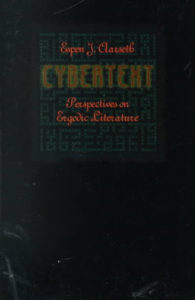The academic study of video game design has deep roots in many disciplines, stretching across the humanities, the social sciences, and computer science. Since it is a truly interdisciplinary field, there are as many claims to being the “first” to study them as there are subspecialties within it. Although my own area of interest draws strongly from composition studies and pedagogy as well as game studies, it is dependent on the idea of computer games having the potential to be immersive stories, and as such, much of the seminal work on this dates to the late 1990s.

In Volume 1, issue 1 of Game Studies, Espen Aarseth states “2001 can be seen as the Year One of Computer Game Studies as an emerging, viable, international, academic field.” His book, Cybertext: Perspectives on Ergodic Literature predates his “year one” by four years, as does Janet Murray’s seminal Hamlet on the Holodeck. While not the first works to ever explore the interactive potential for fiction, their work is among the most influential long-form explorations, which laid thegroundwork for more widespread acceptance and formalized study.

Two of the first universities to begin interdisciplinary programs to study computer games were, unsurprisingly, MIT and Georgia Tech. Hamlet on the Holodeck was written while Murray was at MIT, where she began teaching “interactive fiction” in 1992 (Murray, Hamlet ix). She later went on to lead the Information Design and Technology program at Georgia Tech, among the first graduate programs of its kind (Murray “From Game-Story…” 6). Both these schools, sharing both a rigorous program of study in fields that fed into game studies and a student body with a passion for roleplaying games (live and tabletop) as well as computer games, proved fertile ground for new research programs. Over time, degrees in “Game Design” have sprung up at colleges and universities at all levels. However, most focus primarily on the art and technology that go into the creation of games, with analysis being pragmatic and not theoretical.
The high level of interest on the part of students, and the increasing demand for highly skilled workers in the ever-expanding field of video game design and production, has led to the development of these programs as a means of credentialing and training students to fill these roles. Beyond the notion of filling a market demand on the part of students and industry, Aarseth states a more philosophical imperative for the establishment of formalized video game studies, stating, “Today…we have a billion dollar industry with almost no basic research, we have the most fascinating cultural material to appear in a very long time, and we have the chance of uniting aesthetic, cultural and technical design aspects in a single discipline.”
However, some designers, like “Extra Credits” James Portnow, argue that game design programs often fail to provide the broad humanities base necessary to prepare students to be professional designers (Extra Credits). Turf wars over the disciplinary relationship between game studies and more established departments must take into account the primary purpose of schools, after all – the teaching of students. There exists a potential conflict between what is best for students (broad-based undergraduate programs with a strong liberal arts component, and more specialized, in-depth graduate study of games) and what may be best for career academics, who have a career imperative to carve out their own niche and identity as researchers.
I would argue, however, that for a well-rounded understanding of the field, study – whether formal or informal – of multiple disciplines is necessary. Individual disciplines may provide a theoretical framework for analysis, as well as their own rich traditions of the many elements that make up game design. And while Aarseth allows that “games should also be studied within existing fields and departments, such as Media Studies, Sociology and English,” he then goes on to say that “games are too important to be left to these fields.”
The demand on the part of students and industry for game design programs means that departments will continue to exist at least as long as the tuition dollars are there, and they have an important research contribution to make to the university community as well. There will be scholars who identify with these departments exclusively, and see researchers from related disciplines as interlopers. Such is the nature of interdisciplinary studies and departments, and Game Studies is not the first, nor will it be the last, to experience this conflict.
In the case of English Studies, studies of game design and game narrative open up new possibilities to explore issues underlying writing pedagogy, as well as an evolving definition of narrative that allows for agency on the part of the “reader” as well as the writer. Scholars of English Studies have much that they can contribute, and much that they can learn as well from this burgeoning field…if disputes over who has the “right” to study games do not get in the way.
Aarseth, Espen. “Computer Game Studies, Year One”. Game Studies. July 2001. http://gamestudies.org/0101/editorial.html.
Extra Credits. “Educating Game Designers – Too Much “Game” at Game Schools – Extra Credits.” YouTube. YouTube, 20 Apr. 2016. Web. 22 Sept. 2016.
Murray, Janet. Hamlet on the Holodeck. MIT P, 1997.
Murray, Janet. “From Game-Story to Cyberdrama” in First Person, edited by Noah Wardrip-Fruin and Pat Harrigan. MIT P, 2004, p. 2-11.

